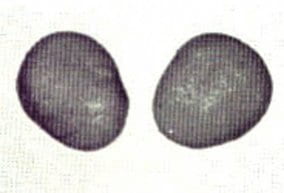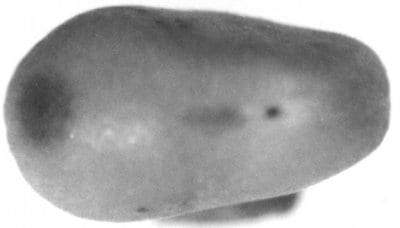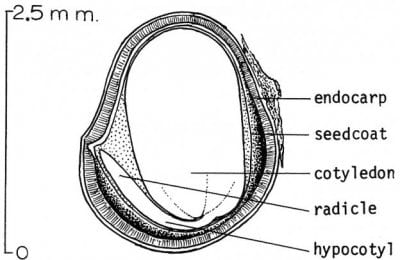Rhus spp.
Rhus spp. – Sumacs
Anacardiaceae

Figure 1. Seeds of smooth sumac (6.5x) Rhus glabra L. (x 6.5).
Elliptic-ovoid seeds of Rhus sp. fruits gathered from the wild have been found in many archaeobotanical assemblages. Carbonized sumac seeds have been recovered by flotation and identified from various open sites in eastern North America, along with a few caches of sumac seeds on prehistoric sites. Also, sumac seeds have been found in paleofecal material.
Description

Figure 2. Position and shape of hilum on smooth sumac seed (16x).
The shape of the seeds (nutlets) is elliptic-ovoid, wider on one end and slightly compressed on the other end. The modern seeds do not differ in overall shape and size from carbonized ones, and recognition of the archaeobotanical specimens on the basis of comparison with the modern ones should not be difficult, if whole seeds are preserved (Figure 1). Dimensions of seeds range from ca. 2.5 mm (length) x 2.1 mm (width) x 1.7 mm (thickness). The surface of the seed-coat is smooth. The hilum (point of the attachment of the seed to the stalk) is linear in shape and located on the longer edge of the seed (Figure 2). The hilum is not pronounced and it comprises only ca. 1/9 of the circumference of the whole seed. In cross section, the seeds are flattish to ovoid and the edges are not sharply angled. The seed wall consists of two striate layers (Figure 3) with a very thin layer between (Martin and Barkley 1961:178). Fruits occur in very dense clusters on the branches. The fruits of non-poison sumacs consists of small red hairy drupes that are single seeded and without endosperm (Figure 4).

Figure 3. Longitudinal section through seed of staghorn sumac Rhus typhina L. (from Brinkman 1974:716, Figure 3).
The seeds of smooth sumac (Rhus glabra L.) can be easily confused with seeds of dwarf sumac (Rhus copallina L.) and/or staghorn sumac (Rhus typhina L.). The seeds of all three species have very similar overall shape and size, and cannot be separated to the species level solely on the basis of seed morphology. However, the seeds of the above mentioned species can be distinguished from poison sumac (Rhus vernix L.) and poison ivy (Toxicodendron radicans (L.) Kuntze; Steyermark: Rhus radicans L.) seeds which are constricted in the middle, and which have a recessed hilum. Surfaces of seeds of poison sumacs have irregular ridges and grooves lengthwise. In cross section, a seed wall of poison sumac consists of one thick striate layer (Martin and Barkley 1961:178).
Archaeological Distribution

Figure 4. Fruits of smooth sumac (1.2x).
The earliest evidence for the presence of sumac seeds in archaeological assemblages dates before 7000 B.P. (Smith 1992:282). Sumac seeds were identified in seven paleofecal specimens from Salts Cave in Kentucky, dating to the Early Woodland Period (Yarnell 1969). Similarly, when the remains of an Ozark rockshelter were excavated, the body of an elderly woman was found buried. Sumac fruit was found to be the principal food she had last consumed. Dating of this find is not known yet (Kindscher 1987:190-194). Johannessen (1984:201-202) has identified sumac seeds from the Early and Middle Woodland components of the sites excavated during the FAI-270 Project in the American Bottom area. Scarry (1986:265) identified 309 charred sumac seeds from a single late West Jefferson feature at the Moundville site in Alabama, dated to the Late Woodland Period. In addition, there was a rather ubiquitous presence of sumac seeds in other samples from the same phase. However, fewer sumac seeds were found in the samples from the later Moundville I phase at the same site. Likewise, Wagner (1987) identified sumac seeds at the Incinerator site and other Fort Ancient sites. Because sumac seeds were present in rather large quantities, she suggested that sumac plants were allowed to grow within the stockade of the ancient village at the Incinerator site in Ohio. Furthermore, a single pit at the Blain site in Ohio, another Fort Ancient site yielded 4,700 charred sumac seeds (Kaplan 1970).
The Modern Plant and Its Distribution
Most of the sumac species are attractive ornamental plants that have showy red berries, and the leaves turn from dark green to a brilliant red color in the fall. However, poison sumacs have white berries. The sumacs include about 150 species of shrubs or trees of the temperate and subtropical regions, but only eight are native to North America (Brinkman 1974:715-720). Several are common in America. Those are fragrant sumac (Rhus aromatica Aiton), dwarf sumac (R. copallina), smooth sumac (R. glabra), staghorn sumac (R. typhina), poison ivy (R. radicans) and poison sumac (R. vernix). Poison sumacs were classified by some taxonomists in a separate genus, Toxicodendron (Steyermark 1963:1006), but have been put back into genus Rhus (Yatskievich and Turner 1990:16).
Many of the sumacs can thrive on rather poor soils, such as sandy and even salty soils. However, they prefer sunny and moist places. They grow near roadsides, seashores, in thickets, and hence their rather ubiquitous presence in archaeological assemblages from various eastern North American sites. Sumacs can be propagated by seeds that are dispersed entirely by birds or other animals, but can also spread vegetatively.
Discussion
Fragrant, dwarf, and smooth sumac fruits have a sour tasting fruit and a pink drink, often called an “Indian lemonade,” can be made when sugar is added. The berries contain malic acid and vitamins A and C (Angier 1993). There is ethnographic evidence that Native groups used it for making a refreshing drink or tea. Young shoots or peeled roots were eaten fresh by Iroquois. Furthermore, dried berries and leaves were mixed with tobacco and smoked by Indians in peace pipe ceremonies (Brill and Dean 1994). Ethnohistoric accounts indicate that Indians as well as Euroamericans in the rural Ozarks used sumacs for making chew sticks. Sumac sticks contain a high active antibiotic substance which is effective against tooth decay and gum disease. Also, sumac’s leaves and bark contain tannin which can be extracted and used as a dye for leather and wood. Sumac seeds and leaves are browsed by deer and eaten by wild turkey, and other small animals and birds.
On the basis of archaeological evidence and ethnohistoric accounts, it seems that Native groups in northeastern America used sumacs rather frequently. Although there are many berries per sumac plant, the finds of almost pure sumac seed caches, in addition to the ubiquity of its presence in archaeological assemblages, probably indicate wider and possibly more intensive use of sumacs by Native groups than discussed in the archaeobotanical literature.
Written by: Ksenija Borojevic
References
- Angier, B.
1993 Field Guide to Wild Medicinal Plants. Stackpole Books, Harrisburg. - Brill, S., and E. Dean
1994 Identifying and Harvesting Edible and Medicinal Plants in Wild (and Not So Wild) Places. Hearst Books, New York. - Brinkman, K. A.
1974 Rhus L. Sumac. In Seeds of Woody Plants in the United States, by C. S. Schopmeyer, pp. 715-720. Agricultural Handbook No. 450. U. S. Department of Agriculture, Washington, D. C. - Johannessen, S.
1984 Plant Remains. In American Bottom Archaeology, edited by C. J. Bareis and J. W. Porter, pp. 197-214. University of Illinois press, Urbana. - Kaplan, L.
1970 Plant Remains from the Blain Site. In Blain Village and the Fort Ancient Tradition in Ohio, edited by O. H. Prufer and O. C. Shane III, pp. 227-231. Kent State University Press, Ohio. - Kindscher, K.
1987 Edible Wild Plants of the Prairie: An Ethnobotanical Guide. University Press of Kansas, Lawrence. - Martin, A. C., and W. D. Barkley
1961 Seed Identification Manual. University of California Press, Berkeley. - Scarry, C. M.
1986 Change in Plant Procurement and Production during the Emergence of the Moundville Chiefdom. Unpublished Ph.D. dissertation, Department of Anthropology, University of Michigan, Ann Arbor. University Microfilms, Ann Arbor. - Smith, B. D.
1992 Rivers of Change: Essays on Early Agriculture in Eastern North America. Smithsonian Institution Press, Washington, D.C. - Steyermark, J. A.
1963 Flora of Missouri. Iowa State University, Ames. - Yarnell, R. A.
1969 Contents of Human Paleofeces. In The Prehistory of Salts Cave, Kentucky, by P. J. Watson, pp. 41-54. Illinois State Museum, Reports of Investigations 16. Springfield. - Yatskievich, G., and J. Turner
1990 Catalogue of the Flora of Missouri. Monographs in Systematic Botany from the Missouri Botanical Garden, St. Louis. - Wagner, G. E.
1987 Uses of Plants by the Fort Ancient Indians. Unpublished Ph.D. dissertation, Department of Anthropology, Washington University, St. Louis.